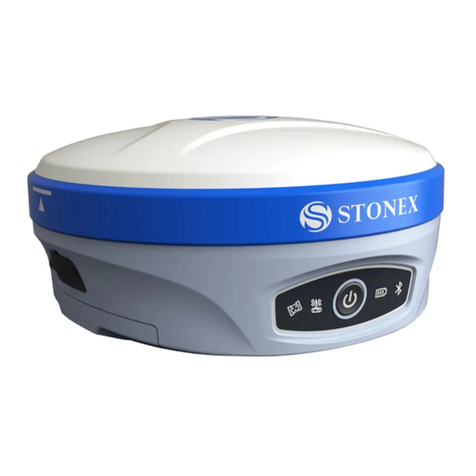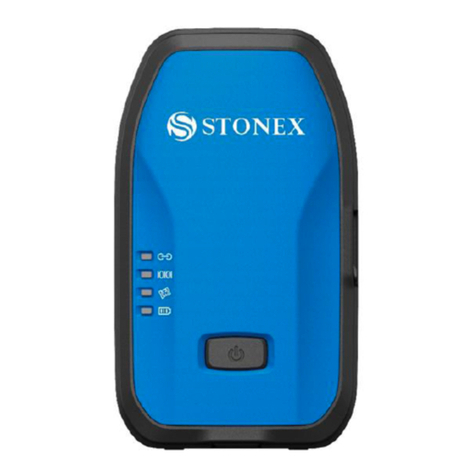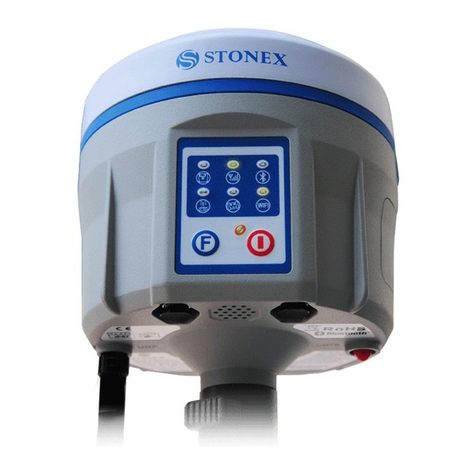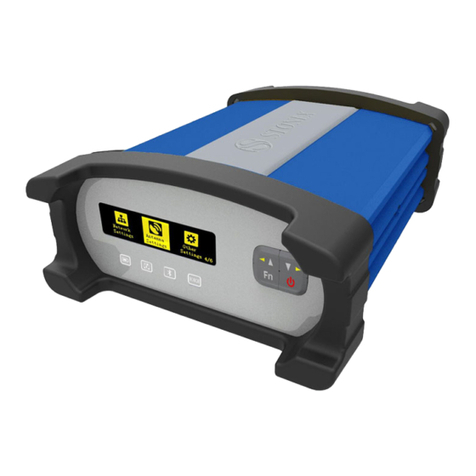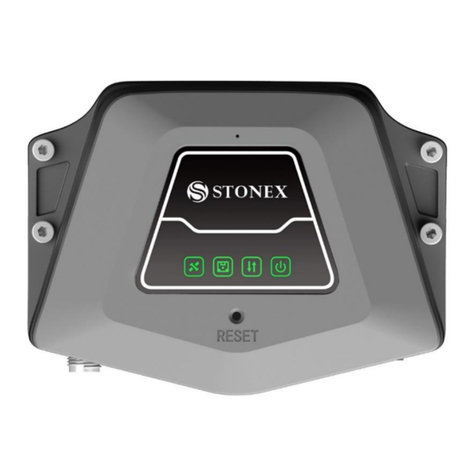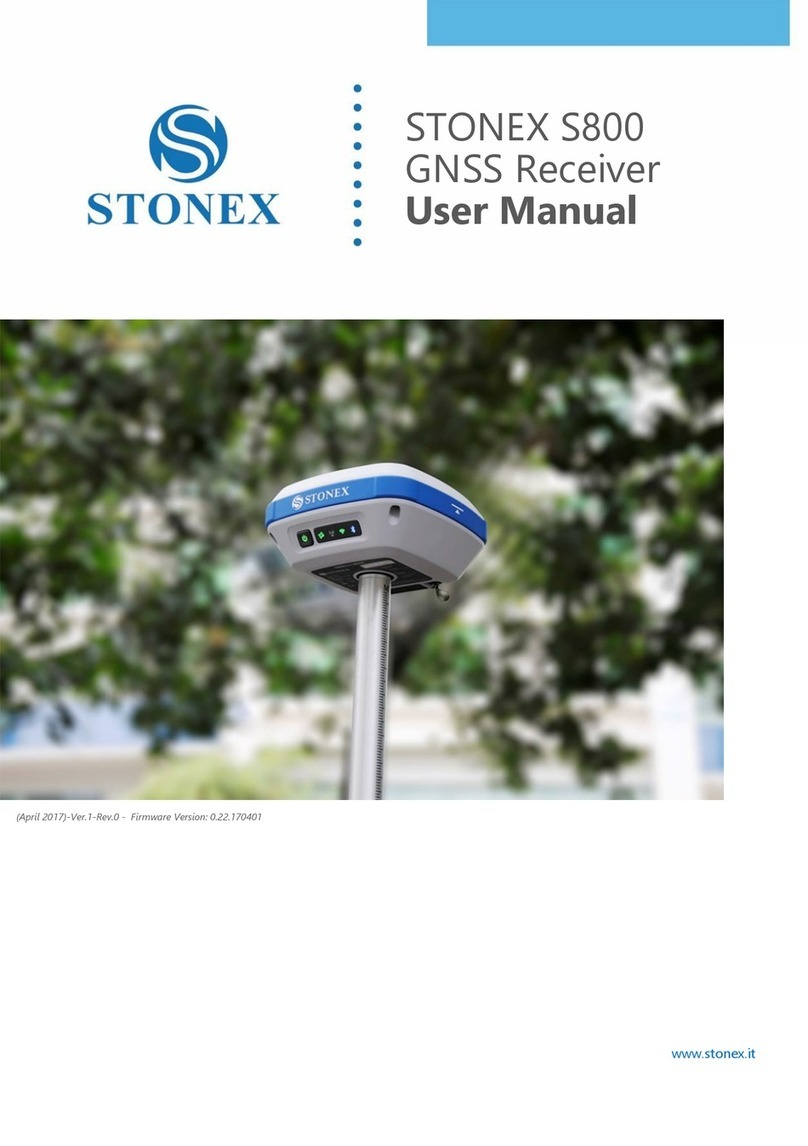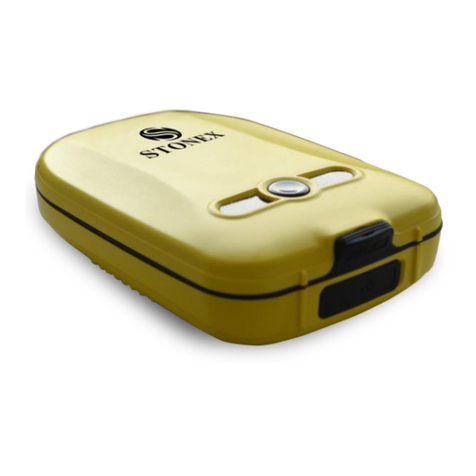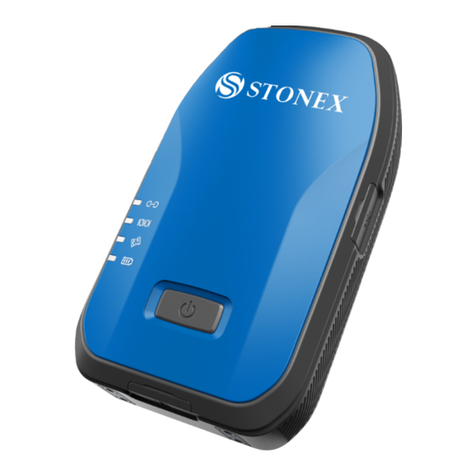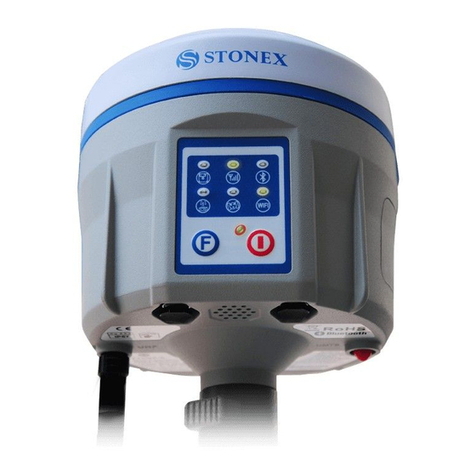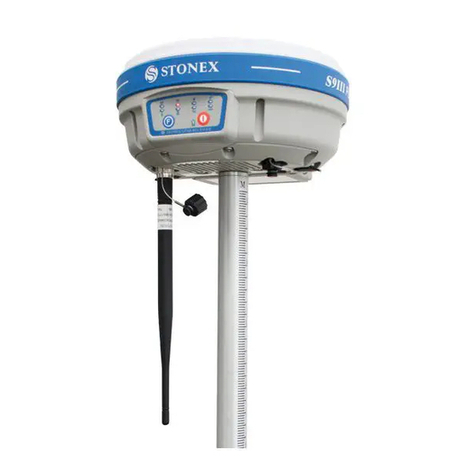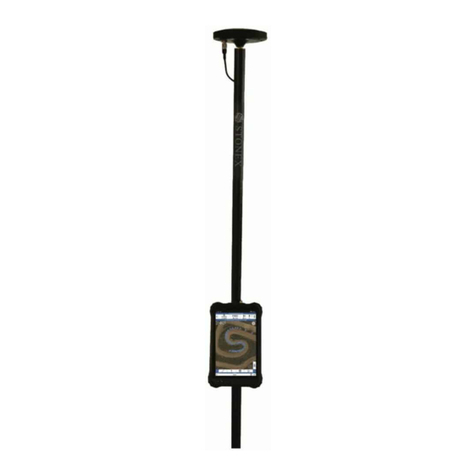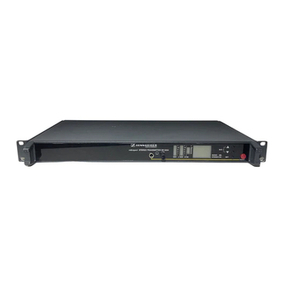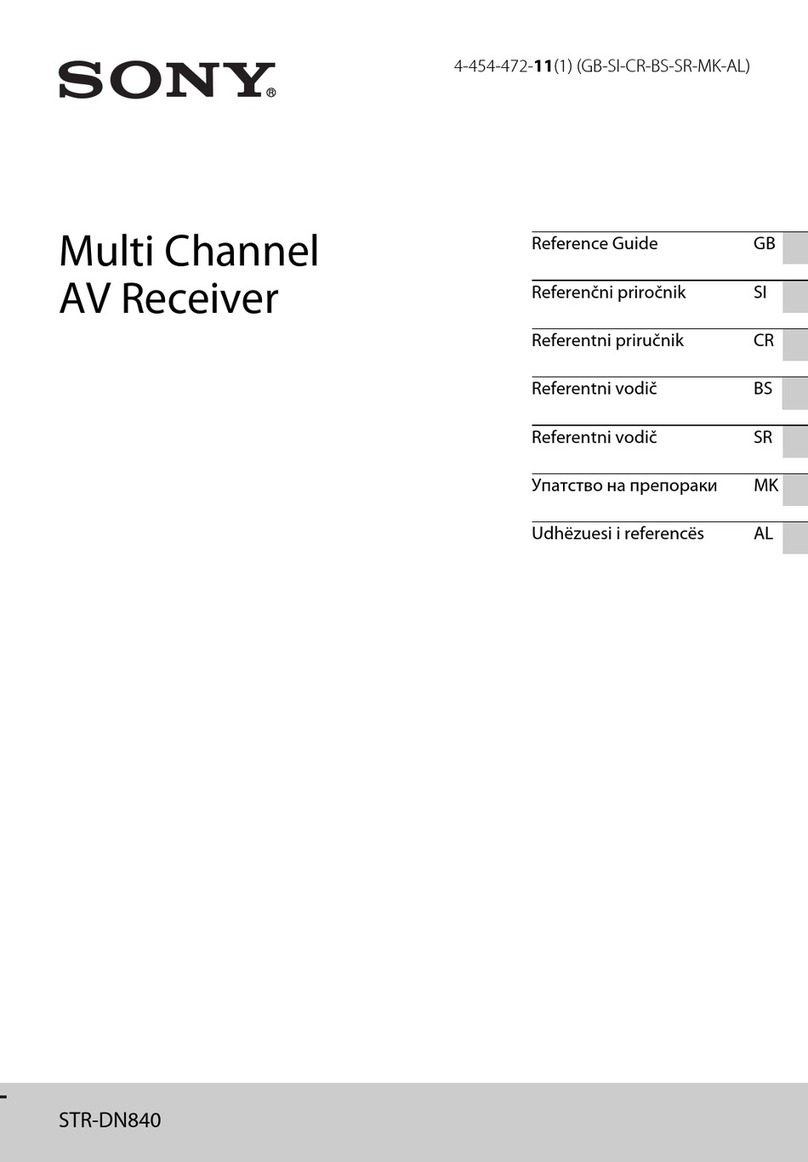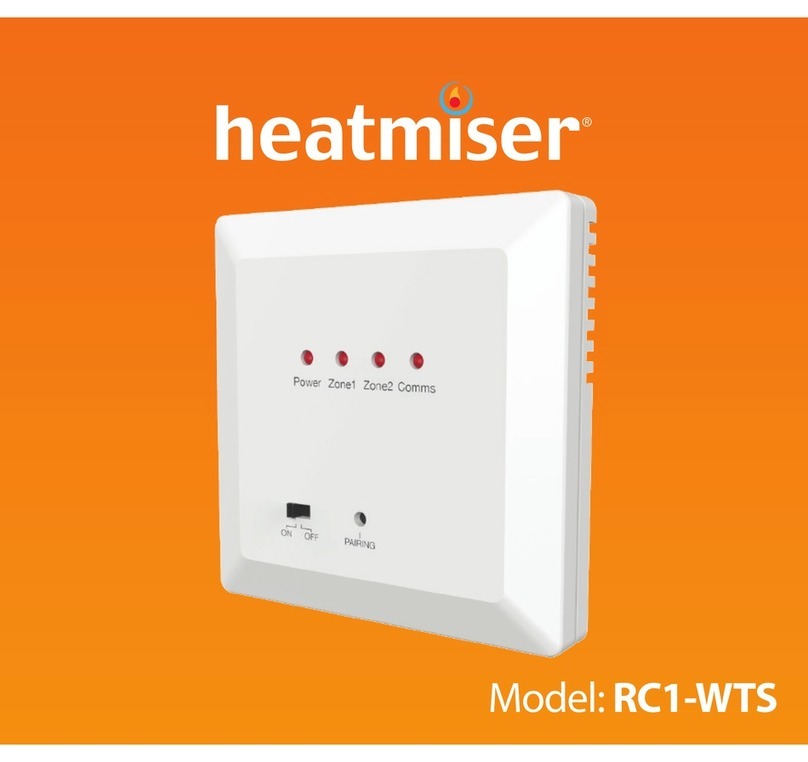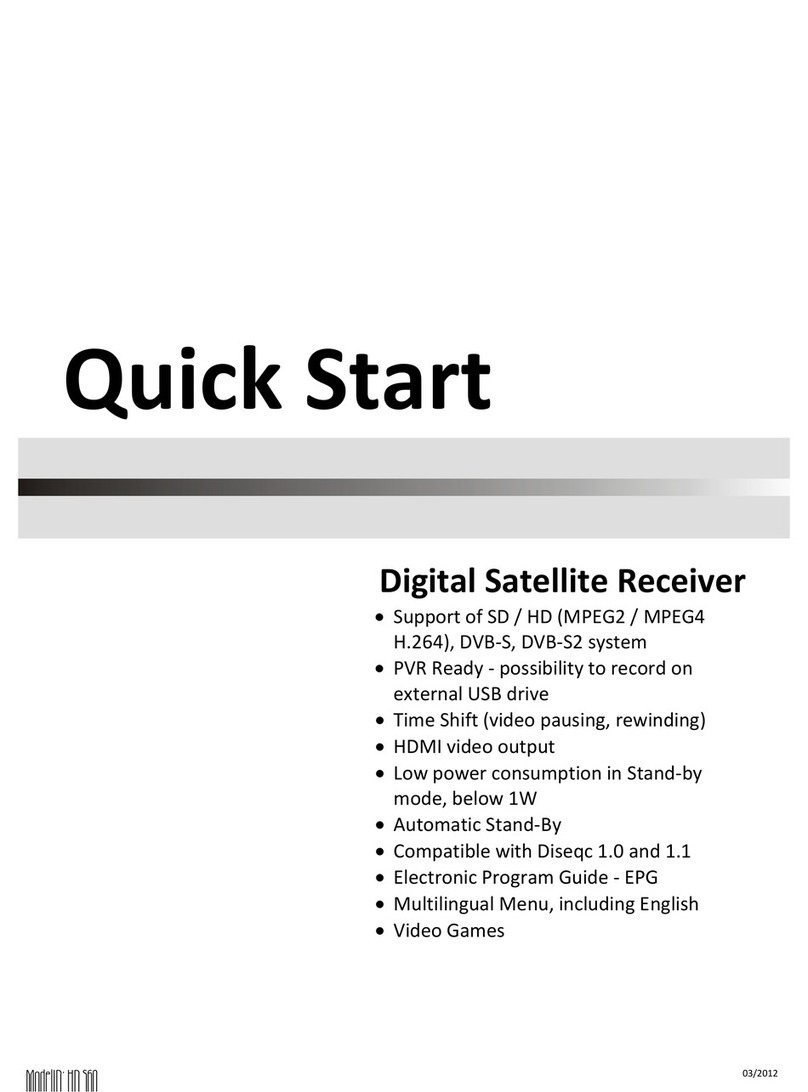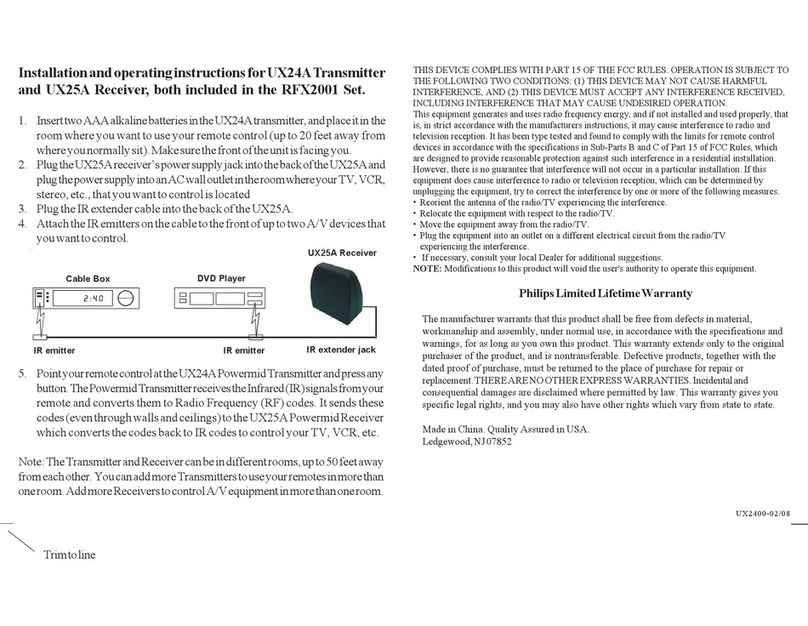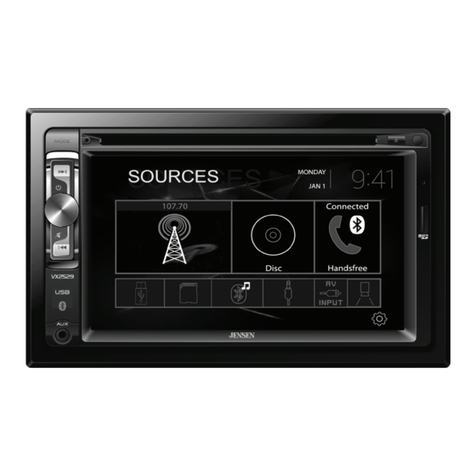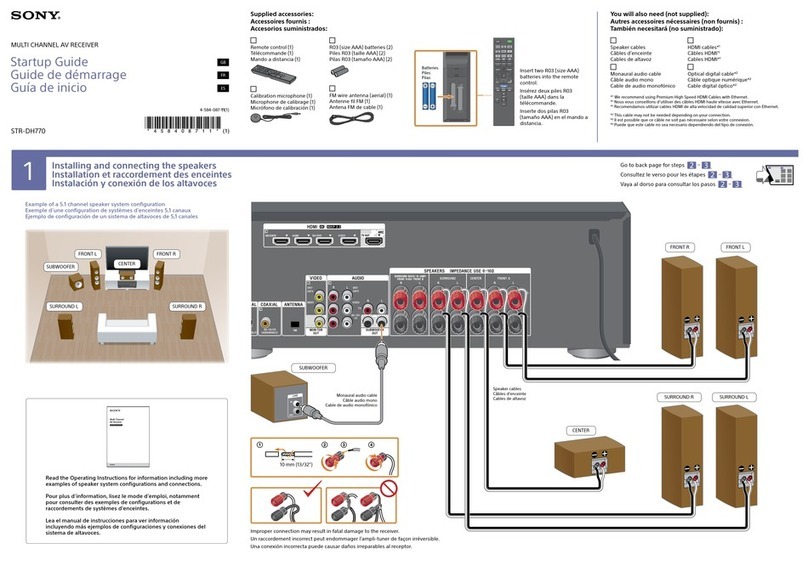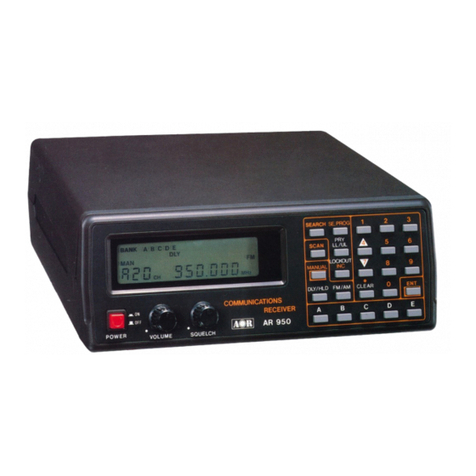STONEX S850A User manual

STONEX S850A
GNSS Receiver
User Manual
Jan 2020 - Ver.1 - Rev.1
www.stonex.it

Stonex S850A GNSS Receiver –User Manual 1
Contents
Introduction ...................................................................................................................................... 3
1. Receiver appearance..................................................................................................................... 5
1.1 Front view........................................................................................................................5
1.2 Bottom view...................................................................................................................7
2. Web Interface................................................................................................................................ 8
2.1 Status ................................................................................................................................8
2.2 Settings ............................................................................................................................8
2.2.1 Working mode ...................................................................................................9
2.3 Download.....................................................................................................................10
2.4 Management .............................................................................................................. 10
2.4.1 Install new firmware...................................................................................... 10
2.4.2 Device register................................................................................................. 10
2.5 Set the language....................................................................................................... 11
3. Basic operation ........................................................................................................................... 12
3.1 Power on receiver..................................................................................................... 12
3.2 Power off receiver..................................................................................................... 12
3.4 Receiver self-check...................................................................................................12
3.5 Insert SIM card........................................................................................................... 13
4. Accessories .................................................................................................................................. 14
4.1 Carrying case ..............................................................................................................14
4.2 Standard accessories............................................................................................... 14
5. Technical specification ............................................................................................................... 15
Appendix 1: Default radio configuration ..................................................................................... 18
Appendix 2: Copyrights, warranty and environmental recycling .............................................. 20
Copyrights and trademarks ......................................................................................... 20

Stonex S850A GNSS Receiver –User Manual 2
Release Notice................................................................................................................... 20
Standard Limited Warranty..........................................................................................20
Shipping policy ................................................................................................................. 21
Return policy Dead On Arrival instruments .......................................................... 21
Firmware/Software warranty ....................................................................................... 22
Over Warranty repair(s) policy.................................................................................... 22
Disclaimer and Limitation of Remedy ..................................................................... 22
Instruments......................................................................................................................... 23
Accessories.......................................................................................................................... 23
Environmental recycling................................................................................................ 24
For countries in the European Union (EU)............................................................. 24
For countries outside European Union (EU) ......................................................... 24
Appendix 3: Safety Recommendations......................................................................................... 25
Warnings and Cautions ................................................................................................. 25
Wireless Module Approval........................................................................................... 25
Instrument Approval.......................................................................................................26
UHF 410-470 MHz / 902.4-928 MHz Data transceiver..................................... 26

Stonex S850A GNSS Receiver –User Manual 3
Introduction
This document is user guide for S850A and it is intended to introduce how to
use the receiver correctly.
S850A GNSS receiver is a multiple-frequency receiver and designed for GNSS
surveying applications. It is available as a base station, or as a standalone
rover, which can be switched freely whenever and wherever, offering
maximum versatility in the system configuration to meet your specific
requirements. At the same time, S850A receiver can upgrade easily to
continually meet your new demand.
The integrated design of the receiver makes the S700A only 1.1 kg, which is
light and portable. The internal antenna supports all the satellite systems:
GPS, GLONASS, Galileo, Beidou, , QZSS, IRNSS. And users no longer have to
worry about upgrading RTK hardware to support other satellite systems.
The receiver is provided with electronic bubble so it’s possible to survey
corner points with inclined pole up to 30 degrees using the “point by 3
inclined measures” function.
An important feature inside S850A is Atlas reception: Atlas is a differential
corrections systems broadcasted on L-Band, allowing increase in position
accuracy in area not covered by conventional CORS working under Ntrip
Technology (lack of reference stations, lack of GPRS signals, etc). Atlas is
broadcasted by satellite systems, so the reception is nearly ensured all over
the world. Atlas uses similar technology compared to SBAS, but providing
better positioning accuracy.
Another important feature is the new modem GSM. Worldwide LTE,
UMTS/HSPA+ and GSM/GPRS/EDGE coverage Multi-constellation GNSS
receiver available for applications requiring fast and accurate fixes in any
environment. EG25-G is backward-compatible with existing EDGE and
GSM/GPRS networks, ensuring that it can be connected even in remote areas
devoid of 4G or 3G coverage.

Stonex S850A GNSS Receiver –User Manual 4
This chapter provides basic information to help you get familiar with your
GNSS receiver.
Key Features:
•Rugged housing
•Support full constellation satellites
•4G LTE and Bluetooth / WLAN datalink support
•UHF datalink with internal 1 W radio module
•Easy configuration from Web UI and remote server.
•Support E-bubble
•Intelligent connection
•IP67

Stonex S850A GNSS Receiver –User Manual 5
1. Receiver appearance
1.1 Front view
Figure 1.1: Receiver front view
The following table contains the description of the receiver front view.
ITEM
DESCRIPTION
1. Satellite indicator
Off: no satellite tracked
Flashing red: satellites tracked but not
positioned
Flashing green: satellites positioned but
not fixed
Green: fixed solution
Flashing green and red alternately:
GNSS board abnormal
2. Datalink indicator
Green: datalink setting succeeds
Flashing green: data in normal
transmission
Red: In static mode
Flashing red: in static mode, flashing
red according to static sampling
interval

Stonex S850A GNSS Receiver –User Manual 6
3. Wi-Fi indicator
Green: Wi-Fi is enabled
Off: Wi-Fi is disabled
4. Bluetooth indicator
Blue: Bluetooth has connected
Flashing blue: Bluetooth has connected
and has data transmission
Off: No connection
5. Power button
Switch on/off the receiver; short press
to broadcast current operation mode
and status.
Green: The power supply is enough
Flashing green (1s): power in 10%-20%
Flashing red (1s):
power<10%
Flashing red (3s): The device is charging

Stonex S850A GNSS Receiver –User Manual 7
1.2 Bottom view
Figure 1.2: Receiver bottom view
The following table contains the description of the receiver bottom view.
ITEM
DESCRIPTION
1. UHF
TNC, external UHF antenna
connector
2. SIM card slot
Nano SIM card interface
3. 5-pin LEMO
Connect the external power
supply and external radio
4. Type-C
Power supply and data transfer

Stonex S850A GNSS Receiver –User Manual 8
2. Web Interface
S850A receiver has Web UI functionality. By getting access to its internal
hotspot, you can easily manage it on the Web UI. As long as you have a
smart phone, PC or handheld with WIFI functionality, you can easily connect
to the S850A receiver to view status, download data and configure the
receiver.
S850A receiver is default to open WIFI automatically when it’s powered on.
Use smart phone/PC/handheld to search the receiver hotspot, whose name is
its serial number, and connect it. Receiver WIFI only supports getting access
to Web UI to check status and set up mode, not for Internet connection.
The WIFI hotspot name is the serial number of the receiver.
Enter the IP address: 192.168.10.1. A window will pop up when the user log
in, which need to fill in the user, that is “admin”, and password that is
“password”.
2.1 Status
The status page displays the current state of S850A receiver, including
position information, data link status, satellite charts, and instrumentation
information. Click on a module to display its details.
2.2 Settings
The Settings page includes working mode, satellite Settings, device
configuration, NMEA messages, view logs, and configuration sets. You can
set the host mode, satellite system, system parameters, and NMEA message.
And you can view and download the logs as well. Also you could upload,
download, delete and apply the related configuration. Click on a module to
display its details.

Stonex S850A GNSS Receiver –User Manual 9
2.2.1 Working mode
You can select different work mode to configure, static, rover and base. In
different mode, there are different configuration you can make.
Static Mode
It’s possible input the point name, antenna height, PDOP threshold. And the
antenna measurement and collect interval. These are all the parameters can
be used in static collection.
At last, there are two record options. If you activate auto record, it will collect
data automatic when you power on the receiver.
Rover Mode
In rover mode, you can select different datalink. Different datalink also has
different options can be edited. The datalink includes UHF, Network, External
and Bluetooth.
If you select UHF mode, then you can select radio channel and radio protocol
as you want. You also can select whether store the raw data. One important
thing, channel 8 is used for inputting, you can input the frequency you want,
but channel 1-7 can’t be edited.
If you select Network, then besides select aRTK timeout and record raw data,
the most important is you can input CORS information, such as IP, account.
If you select External, then it can connect to external radio. There is a very
important thing, the external serial port band rate, this should be same with
external radio.
Then the last it’s Bluetooth, after selecting the datalink as Bluetooth, there
are little option that you can configure.
Base Mode
Base mode also contains different datalink, most of the parameters are same.
The only difference is the base mode has some more options can be edited.
For example you can set the base data type, start base and base position and
so on.
If you select UHF mode, most of the settings are same as rover. But you can
set the radio power.

Stonex S850A GNSS Receiver –User Manual 10
If you select Network, then besides set the data type, site ID, base position
and record raw data, the most important is you can input APN account, APN
user and password, connect mode, caster address and port.
2.3 Download
The download page provides downloads of raw data and backup data. Click
on a module to display its details.
2.4 Management
In this page, the user can upgrade the firmware, register the device, modify
the login password, format the instrument disk, self-check, restore the
factory Settings, restart equipment and other operations.
2.4.1 Install new firmware
In the management of the WEB UI page, you can see that “online update”,
click “browse”, select the required to upgrade the firmware, click the “upload
document”, system will restart to upgrade. After the upgrade, you can view
the current “firmware version” on the “instrument information” page.
2.4.2 Device register
The register code consists of 32 digits and letters. You can register the device
via WEB UI. The detailed steps are shown as followed.
In management page, you can see “registration”. Input register code and
click submit, and then registration is done. After registration, you can check
the expiration time of current registration in the page.

Stonex S850A GNSS Receiver –User Manual 11
2.5 Set the language
As you can see, there is language button in the right-up side of WebUI. And
the S850A has 7 languages to set up. They are Chinese, English, Korean,
Portuguese, Russian, Turkish and Japanese.

Stonex S850A GNSS Receiver –User Manual 12
3. Basic operation
3.1 Power on receiver
Short-Press the power button, the power indicator will light on and you will
hear one beep, then S850A will be powered on.
3.2 Power off receiver
Long press the power button, all indicators interval flashing and the voice
prompted “power off”. Then short-press the power button to confirm power
off.
3.3 Model view and switch
Model view
When receiver is powered on, short press the power button and then it will
voice broadcast the current working mode and data link.
Model switch
When the receiver is powered on, connect it with handheld or other
instruments so as to set up and switch the working mode of receiver.
3.4 Receiver self-check
Self-check functionality is to check whether every module works normally.
When S850A receiver has indicators off or module doesn’t work normally,
you can use self-check to inspect the receiver. S850A self-check consists of
six parts, namely GNSS, radio, network, WIFI, Bluetooth, and sensor. The self-
check results will be voice broadcasted in the process. Self-check operation
and result broadcast are as followed:

Stonex S850A GNSS Receiver –User Manual 13
When receiver is powered on, press power button and hold it until the
receiver voice broadcasts “power off”. Press it again until the receiver sounds
a beep and voice broadcasts “self-check”, which means the receiver starts to
operate self-check. New receiver is recommended to operate self-check at
least once.
In the process of self-check, each module inspection is followed by its
inspection result. If the module inspection passes, it will voice broadcast “OK”
and module led keeps on until the whole self-check finishes. If the module
inspection fails, it will voice broadcast current module inspection fail, keep
module led flashing and buzzer sounding until you restart the receiver. Self-
check lasts for about 1 minute. If there is self-check failure, please contact
local dealer.
If every module indicator is lit with no flashing, and voice broadcast says
every module work normally (such as “GPS self-check. OK.”), it means all the
modules work normally. Receiver starts to work after the whole self-check
finishes
3.5 Insert SIM card
If you need to use the SIM card, you should insert the SIM card before you
power on the S850A; open the card cover first, then insert the SIM card as
the notes in card cover.

Stonex S850A GNSS Receiver –User Manual 14
4. Accessories
4.1 Carrying case
The external appearance of the transport container is shown in the Figure
4.1.
Figure 4.1: External appearance of container
4.2 Standard accessories
Adaptor
Power adaptor (model: KSA-45P-45W) with 4 plugs (US, UK, AU and EU).
Charging cable
Type C -Type C charging cable (model: CTMM-1.5) 1.5 meter long.
Data cable
Type C -USB cable (model: CUTM-1.5) 1.5 meter long.

Stonex S850A GNSS Receiver –User Manual 15
5. Technical specification
RECEIVER
Satellite tracked
GPS: L1 C/A, L1C, L1P, L2C, L2P, L5
GLONASS: G1, G2, G3
BEIDOU: B1, B2, B3, ACEBOC
GALILEO: E1, E5a, E5b, ALTBOC, E6
QZSS: L1 C/A, L1C, L2C, L5, L6
IRNSS: L5
SBAS: 3-channel, parallel tracking
L-Band
ATLAS H10 / H30 / Basic
Channels
700
Position rate
5 Hz, optional 20 Hz⁵
Signal reacquisition
< 1 sec
RTK signal initialization
Typically < 10 s
Hot start
Typically < 15 sec
Initialization reliability
> 99.9%
Internal memory
8 Gb
Tilt Sensor
E-Bubble leveling
POSITIONING1
HIGH PRECISION STATIC SURVEYING
Horizontal
2.5 mm + 1 ppm RMS
Vertical
5.0 mm + 1 ppm RMS
CODE DIFFERENTIAL POSITIONING
Horizontal
<0.5 m RMS
Vertical
<1.0 m RMS
SBAS POSITIONING
Horizontal
<0.6 m RMS2
Vertical
<1.2 m RMS2
REAL TIME KINEMATIC (< 30 Km) –NETWORK SURVEYING3
Fixed RTK Horizontal
8 mm + 1 ppm RMS

Stonex S850A GNSS Receiver –User Manual 16
Fixed RTK Vertical
15 mm + 1 ppm RMS
INTEGRATED GNSS ANTENNA
High accuracy four constellation micro-strip antenna, zero phase center, with internal multipath
suppressive board
INTERNAL RADIO (optional)5
TRM 121 1W
Type
Tx - Rx
Frequency range
410 –470 MHz
902.4 –928 MHz
Channel Spacing
12.5 KHz / 25 KHz
Range
3 –4 Km in urban environment
Up to 10 Km with optimal conditions4
INTERNAL MODEM
GSM integrated
EG25-G
Band
LTE FDD: B1/B2/B3/B4/B5/B7/B8/B12/
B13/B18/B19/B20/B25/B26/B28
LTE TDD: B38/B39/B40/B41
UMTS: B1/B2/B4/B5/B6/B8/B19
GSM: B2/B3/B5/B8
Nano SIM card
COMMUNICATION
I/O connectors
5 pins Lemo, connect the external power supply and
external radio
Type-C, for receiver power supply and data transfer
Bluetooth
V2.1 + EDR /4.0 LE
Wi-Fi
802.11 b/g
Web UI
To upgrade the software, manage the status and
settings, data download, etc. via smart phone, tablet or
other internet enabled electronic device
Reference outputs
RTCM 2.3, 3.2 ,CMR, CMR+, ROX
Navigation outputs
NMEA 0183

Stonex S850A GNSS Receiver –User Manual 17
POWER SUPPLY
Battery
Rechargeable 7.2 V –6.900 mAh
Voltage
9 to 28 V DC external power input with over-voltage
protection (5 pins Lemo)
Working time
Up to 9 hours
Charge time
4 Hours
PHYSICAL SPECIFICATION
Dimensions
140 mm × 140 mm × 71 mm
Weight
1.10 Kg
Operating temperature
30°C to 65°C (-22°F to 149°F)
Storage temperature
-40°C to 80°C (-40°F to 176°F)
Waterproof/ Dustproof
IP67
Shock resistance
Designed to endure to a 2 m pole drop on concrete
floor with no damage
Vibration
Vibration resistant
Specifications are subject to change without notice
1.Accuracy and reliability are generally subject to satellite geometry DOPs), multipath, atmospheric conditions and
obstructions. In static mode they are subject even to occupation times, the longer is the baseline, the longer must
be the occupation time.
2.Depends on SBAS system performance.
3.Network RTK precision depends on the network performances and are referenced to the closest physical base
station.
4.Varies with the operating environment and with electromagnetic pollution.
5. Optional, it can be activated via firmware.

Stonex S850A GNSS Receiver –User Manual 18
Appendix 1: Default radio configuration
The internal radio TRM121 can transmit on the 410-470MHz and 902.4-928
MHz band; users can choose radio channel and radio protocol through the
handheld software or WEB interface. The default frequency of each channel
is in the following table.
Channel
Frequency
1
438.125 MHz
2
440.125 MHz
3
441.125 MHz
4
442.125 MHz
5
443.125 MHz
6
444.125 MHz
7
446.125 MHz
8
447.125 MHz

Stonex S850A GNSS Receiver –User Manual 19
Main features and general performance of the internal radio are summarized
below.
General performance
Frequency range
Fixed frequency: 410-470 MHz
Hopping frequency: 410-470 MHz and 902.4-928 MHz
Band width
Fixed frequency: 12.5 KHz, 25 KHz
Hopping frequency: 280 KHz
Modulation scheme
Hopping frequency: GMSK
Fixed Frequency: GMSK, 4FSK
Transmitter
RF output power
High power (1.0 W)
Modem
Rate
Fixed frequency: 9600bp, 19200bps
Hopping frequency: 115200bps
Modulation
GMSK
Table of contents
Other STONEX Receiver manuals
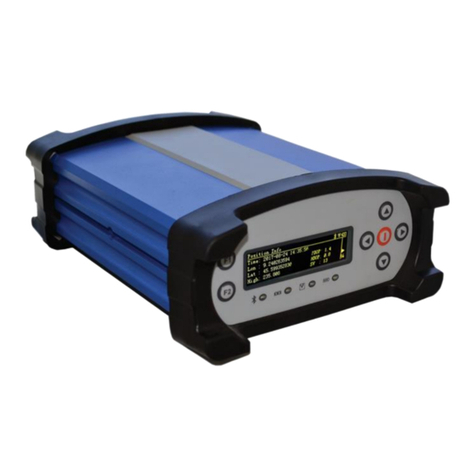
STONEX
STONEX SC2000 User manual
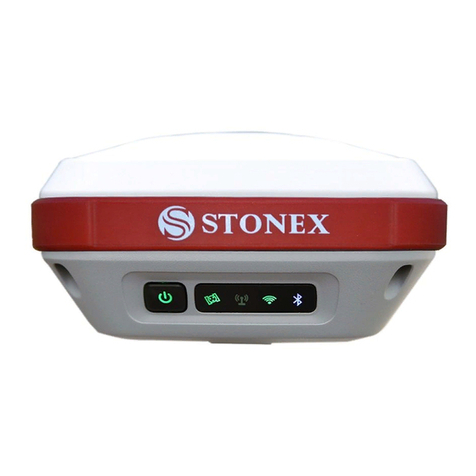
STONEX
STONEX S800A User manual

STONEX
STONEX S900A User manual
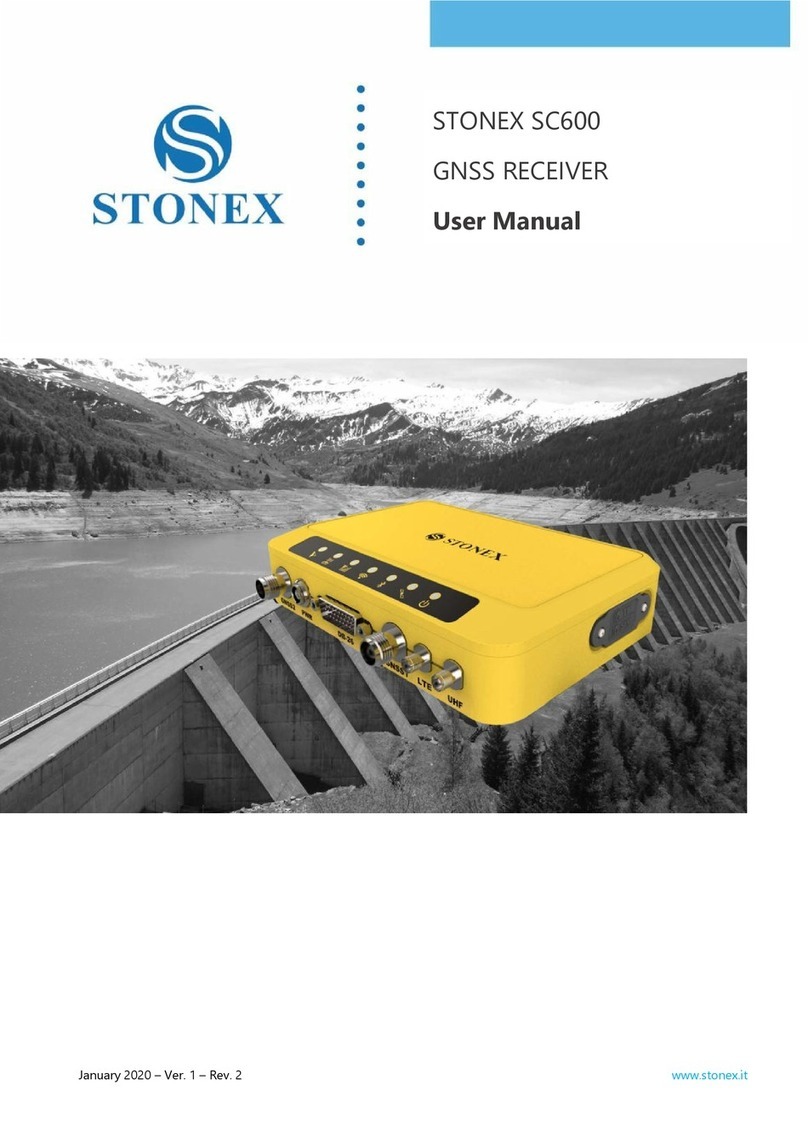
STONEX
STONEX SC600 User manual
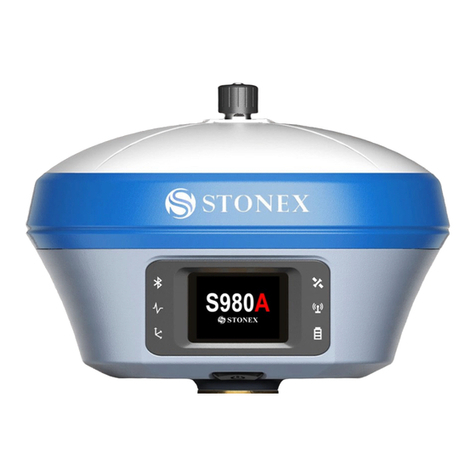
STONEX
STONEX S980A User manual
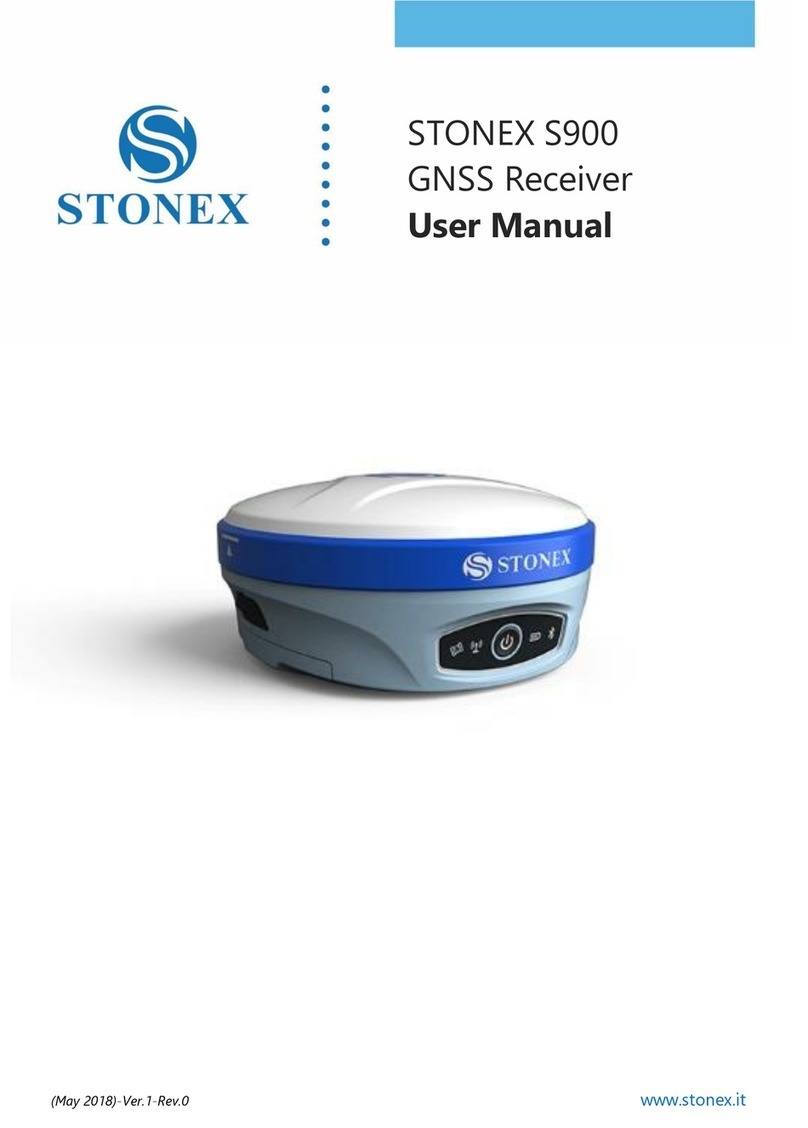
STONEX
STONEX S900 User manual
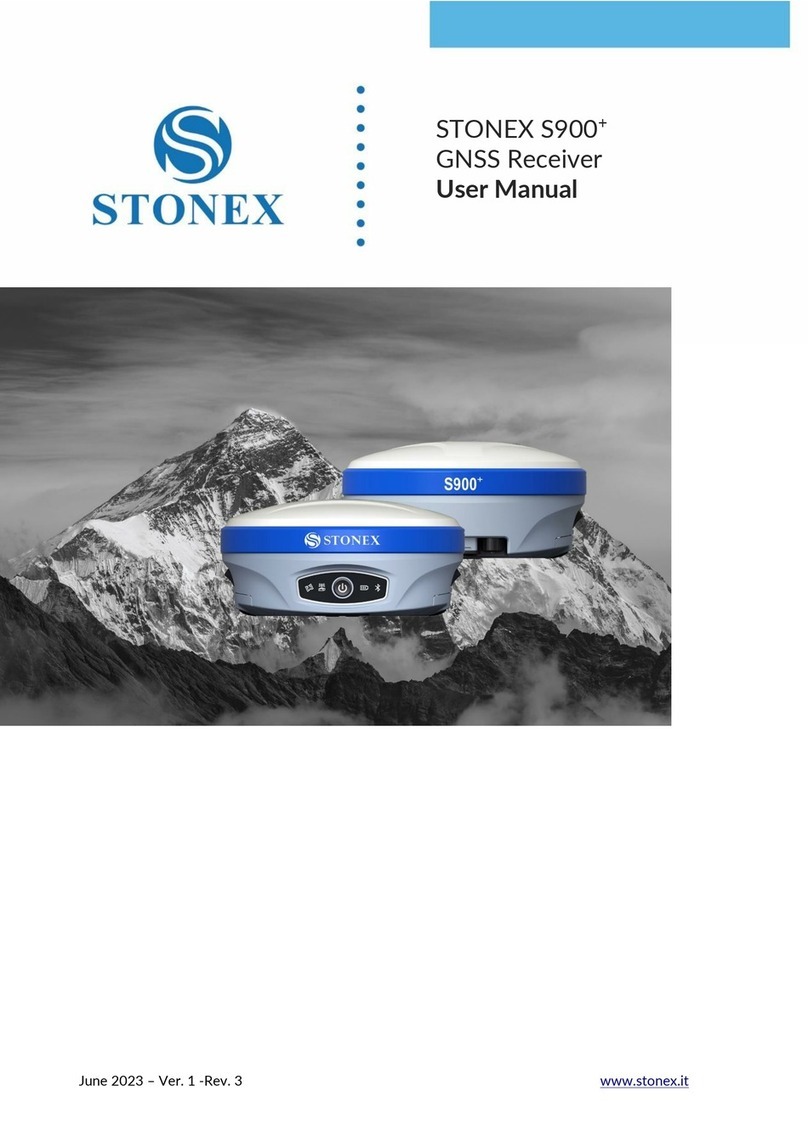
STONEX
STONEX S900+ User manual

STONEX
STONEX S990A User manual
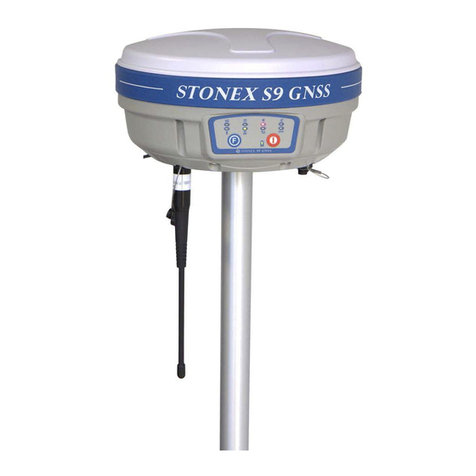
STONEX
STONEX S9 GNSS User manual
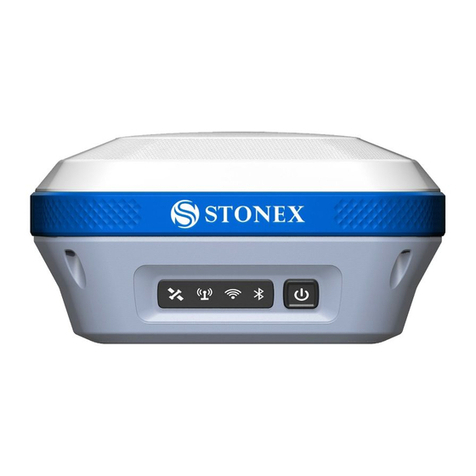
STONEX
STONEX S700A User manual
Popular Receiver manuals by other brands
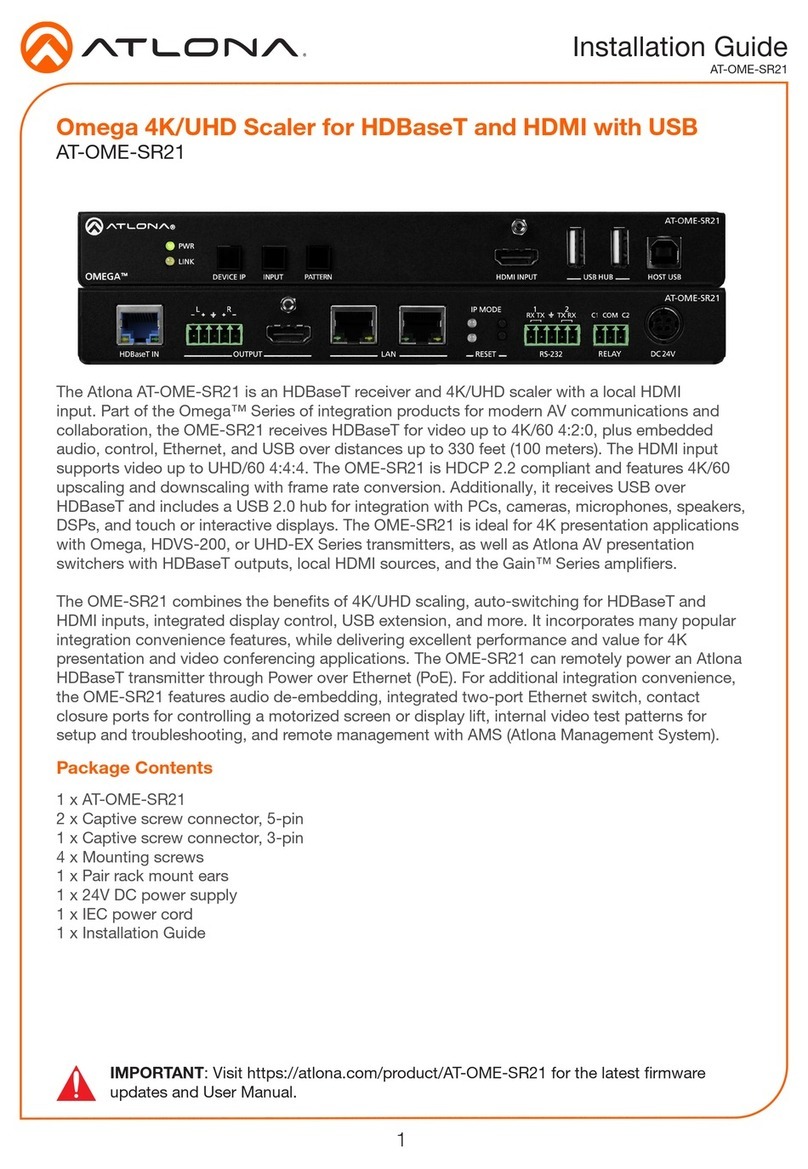
Atlona
Atlona AT-OME-SR21 installation guide
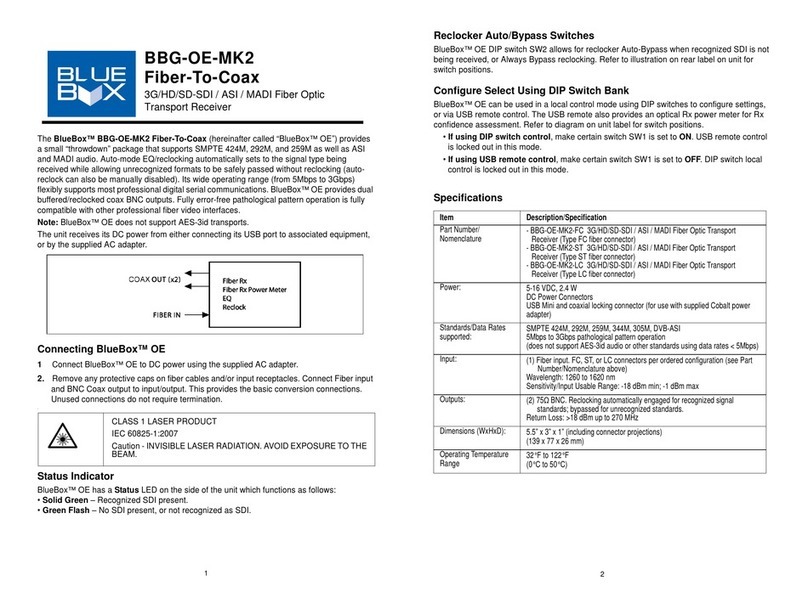
Cobalt Digital Inc
Cobalt Digital Inc BlueBox BBG-OE-MK2 Fiber-To-Coax quick start guide

Agilent Technologies
Agilent Technologies 83446A User's and service guide

AMSTRAD
AMSTRAD DRX100 Sky digibox manual

Hyundai
Hyundai H-CDM8033 instruction manual
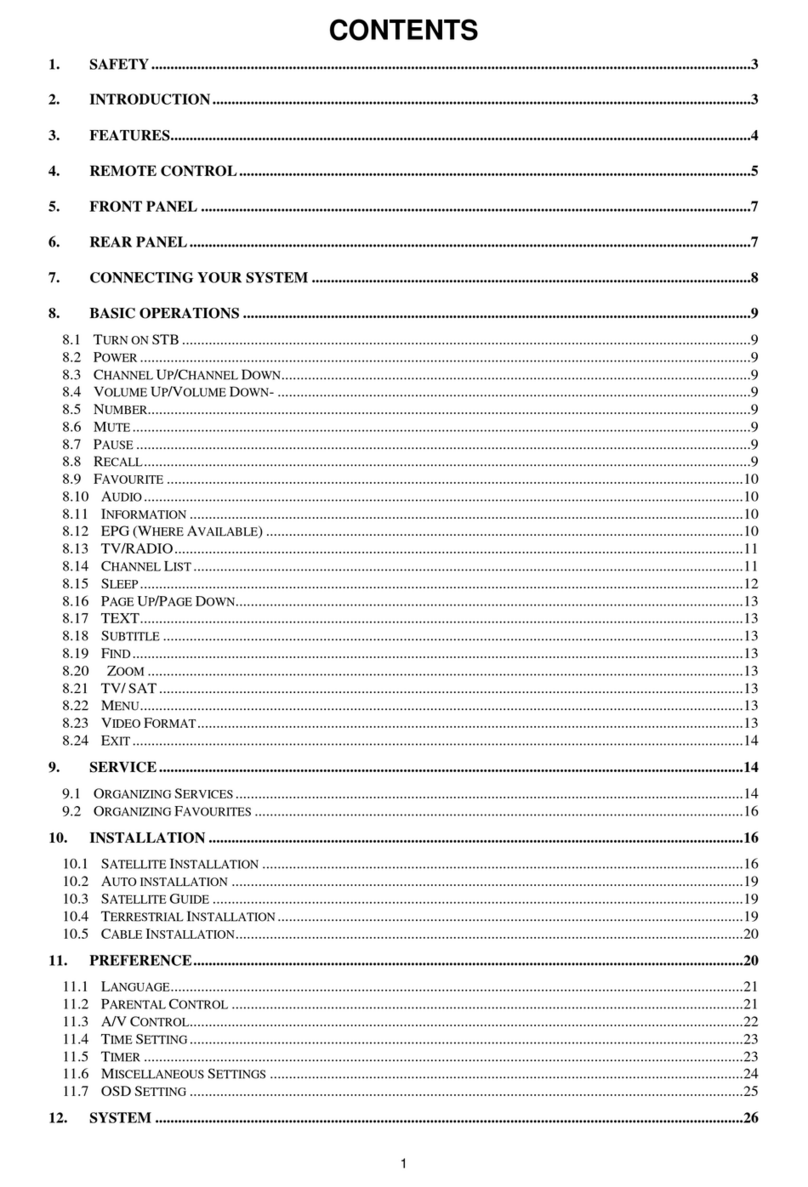
Icecrypt
Icecrypt S3250CCIHD manual
